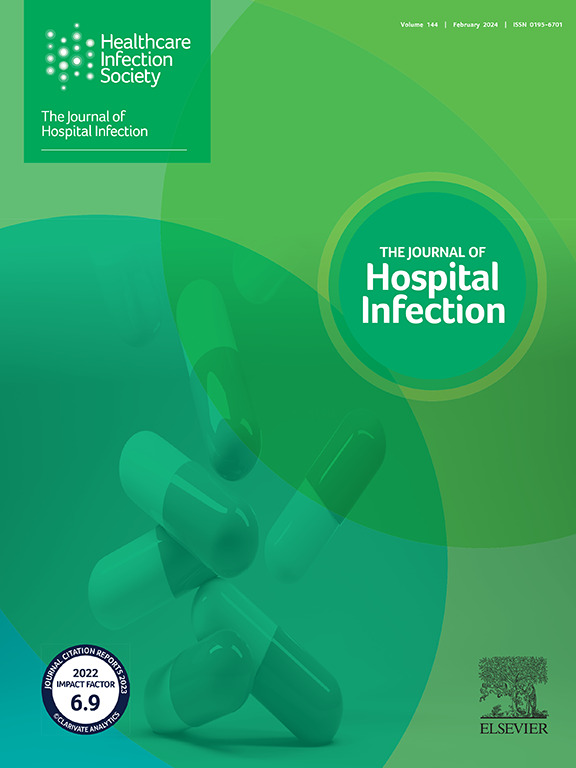Resolving a neonatal intensive care unit outbreak of meticillin-resistant Staphylococcus aureus to the single-nucleotide variant level using Oxford Nanopore simplex reads and HERRO error correction
IF 3.1
3区 医学
Q1 INFECTIOUS DISEASES
引用次数: 0
Abstract
Our laboratory began prospective genomic surveillance for healthcare-associated organisms in 2022 using Oxford Nanopore Technologies (ONT) as a standalone platform. While effective for early outbreak detection, the lower read accuracy compared to Illumina sequencing has limited single-nucleotide variant (SNV) analysis. This study aimed to determine whether Haplotype-aware ERRor cOrrection (HERRO) of ONT data could permit high-resolution comparison of outbreak isolates. ONT simplex reads were used from isolates involved in a recent outbreak of meticillin-resistant Staphylococcus aureus (MRSA) in our neonatal unit. Raw data were basecalled and adapter-trimmed using Dorado v0.7.0, followed by HERRO correction. Genome assemblies and phylogenies were compared with previous analyses (using Dorado v0.3.4 no HERRO correction, and data generated by Illumina sequencing). Five of nine outbreak isolates were analysed; four had insufficient read lengths (N50 values <10,000 bp) and did not achieve complete chromosome coverage post-HERRO correction. The average chromosome sequencing depth for nanopore data was 147× (range: 44–220×) with an average read N50 of 12,215 bp (interquartile range: 11,439–12,711 bp). The median pairwise SNV distance between outbreak isolates from the original investigation was 51 SNVs (range: 40–68), which decreased to 3 SNVs (range: 1–15) with HERRO correction. Illumina sequencing generated a median SNV distance of 2 (range: 0–13). The HERRO-corrected ONT phylogeny closely matched the Illumina-generated phylogeny. HERRO correction enabled high-resolution analysis of MRSA outbreak isolates comparable to Illumina sequencing. ONT sequencing with HERRO correction represents a viable standalone option for detailed genomic analysis of hospital outbreaks, provided sufficient read lengths are achieved.
使用牛津纳米孔单链读取和HERRO错误校正解决新生儿重症监护室耐甲氧西林金黄色葡萄球菌SNV水平爆发。
背景:我们的实验室于2022年开始使用牛津纳米孔技术(ONT)作为独立平台对医疗保健相关生物体进行前瞻性基因组监测。虽然对早期爆发检测有效,但与Illumina测序相比,读取精度较低,限制了单核苷酸变异(SNV)分析。目的:确定ONT数据的单倍型感知错误校正(HERRO)是否可以实现爆发分离物的高分辨率比较。方法:我们使用了最近在新生儿病房爆发的耐甲氧西林金黄色葡萄球菌(MRSA)分离株的ONT单纯性读数。使用Dorado v0.7.0对原始数据进行基础调用和适配器修剪,然后进行HERRO校正。基因组组装和系统发育比较了先前的分析(使用Dorado v0.3.4没有HERRO校正,数据由Illumina测序产生)。结果:对9个爆发分离株中的5个进行了分析;结论:HERRO校正使MRSA爆发分离物的高分辨率分析与Illumina测序相当。ONT测序与HERRO校正是一种可行的独立选择,可用于医院疫情的详细基因组分析,前提是获得足够的读取长度。
本文章由计算机程序翻译,如有差异,请以英文原文为准。
求助全文
约1分钟内获得全文
求助全文
来源期刊

Journal of Hospital Infection
医学-传染病学
CiteScore
12.70
自引率
5.80%
发文量
271
审稿时长
19 days
期刊介绍:
The Journal of Hospital Infection is the editorially independent scientific publication of the Healthcare Infection Society. The aim of the Journal is to publish high quality research and information relating to infection prevention and control that is relevant to an international audience.
The Journal welcomes submissions that relate to all aspects of infection prevention and control in healthcare settings. This includes submissions that:
provide new insight into the epidemiology, surveillance, or prevention and control of healthcare-associated infections and antimicrobial resistance in healthcare settings;
provide new insight into cleaning, disinfection and decontamination;
provide new insight into the design of healthcare premises;
describe novel aspects of outbreaks of infection;
throw light on techniques for effective antimicrobial stewardship;
describe novel techniques (laboratory-based or point of care) for the detection of infection or antimicrobial resistance in the healthcare setting, particularly if these can be used to facilitate infection prevention and control;
improve understanding of the motivations of safe healthcare behaviour, or describe techniques for achieving behavioural and cultural change;
improve understanding of the use of IT systems in infection surveillance and prevention and control.
 求助内容:
求助内容: 应助结果提醒方式:
应助结果提醒方式:


